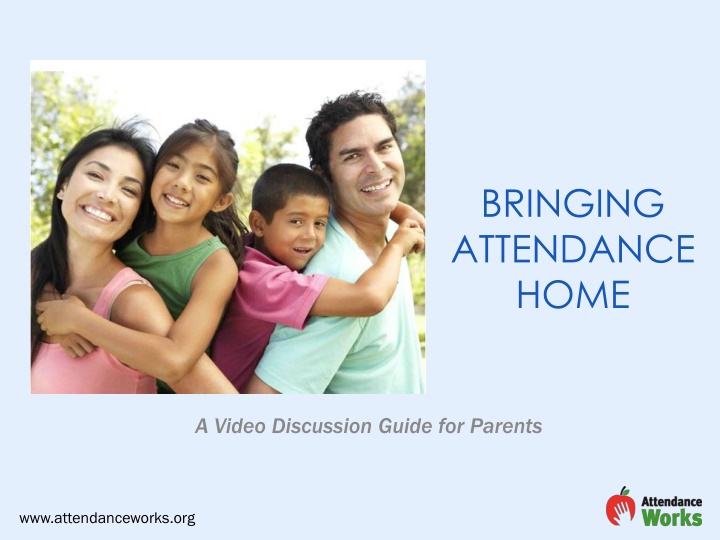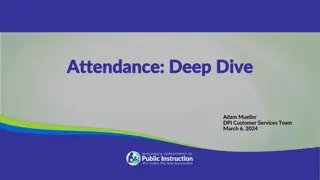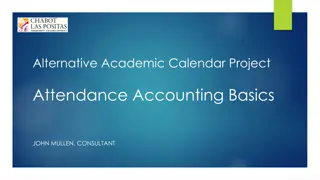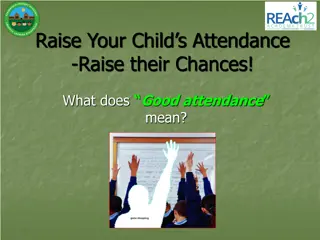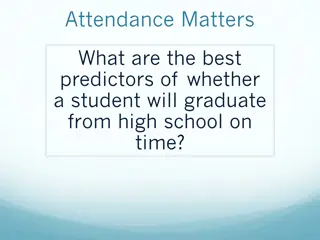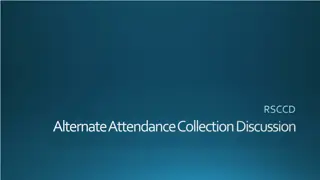Bringing Attendance Home: A Parent's Video Guide
Engage in a video discussion guide for parents focusing on the impact of chronic absenteeism on student success, exploring group norms, an icebreaker session, reactions to the video, and research findings. Understand the consequences of chronic absence and how it affects academic proficiency, particularly in early grades. Take part in discussions about what motivates parents to overcome challenges in ensuring their children attend school regularly.
Download Presentation

Please find below an Image/Link to download the presentation.
The content on the website is provided AS IS for your information and personal use only. It may not be sold, licensed, or shared on other websites without obtaining consent from the author.If you encounter any issues during the download, it is possible that the publisher has removed the file from their server.
You are allowed to download the files provided on this website for personal or commercial use, subject to the condition that they are used lawfully. All files are the property of their respective owners.
The content on the website is provided AS IS for your information and personal use only. It may not be sold, licensed, or shared on other websites without obtaining consent from the author.
E N D
Presentation Transcript
BRINGING ATTENDANCE HOME A Video Discussion Guide for Parents www.attendanceworks.org
Group Norms Create opportunities for everyone to participate Respect different perspectives and experiences Share only what you feel comfortable sharing. You can take a pass if you don t want to share. What would you add or change?
Icebreaker What makes it hard for you as a parent to get your child or children to school every day? What motivates and helps you to get your child to school despite these challenges?
Bringing Attendance Home: A Video for Parents http://www.attendanceworks.org/tools/ for-parents/bringing-attendance-home- video/
Reactions to the Video What do you think of the video s statement about the consequences of chronic absence? Chronic absence is missing 18 days of school over the course of a year, or just 2- 3 days each month
A Summary of the Research The next 5 slides show the impact of chronic absenteeism on student success.
Students Chronically Absent in Kindergarten and Students Chronically Absent in Kindergarten and 1 1st st Grade are Much Less Likely to Read Proficiently Grade are Much Less Likely to Read Proficiently in 3 in 3rd rd Grade Grade Percent Students Scoring Proficient or Advanced on 3rd Grade ELA Based on Attendance in Kindergarten and in 1st Grade 100% 80% 64% 60% 43% 41% 40% 17% 20% 0% No attendance risks Small attendance risks Moderate attendance risks High attendance risks No risk Small risk Moderate risk Missed less than 5% of school in K & 1st Missed 5-9% of days in both K & 1st Missed 5-9% of days in 1 year &10 % in 1 year High risk Missed 10% or more in K & 1st 7 Source: Applied Survey Research & Attendance Works (April 2011)
The Long The Long- -Term Impact of Chronic Kindergarten Term Impact of Chronic Kindergarten Absence is Most Troubling for Poor Children Absence is Most Troubling for Poor Children 5th Grade Math and Reading performance by K attendance for children living In poverty. Academic performance was lower even if attendance had improved in 3rd grade. 52 Average Academic Performance 50 48 46 Reading Math 44 42 40 0-3.3% in K 3.3 - 6.6% in K Absence Rate in Kindergarten 6.6-10.0% in K >=10.0% in K Source: ECLS-K data analyzed by National Center for Children in Poverty (NCCP) Note: Average academic performance reflects results of direct cognitive assessments conducted for ECLS-K. 8
Multiple Years of Elementary Multiple Years of Elementary C Chronic Absence = Worse = Worse M Middle School Outcomes iddle School Outcomes hronic Absence Each year of chronic absence in elementary school is associated with a substantially higher probability of chronic absence in 6th grade 18.0x Chronic absence in 1st grade is also associated with: Lower 6th grade test scores Higher levels of suspension Increase in probability of 6th grade chronic absence 7.8x 5.9x Years of Chronic Absence in Grades 1-5 Oakland Unified School District SY 2006-2012, Analysis By Attendance Works 9
The Effects of Chronic Absence on Dropout The Effects of Chronic Absence on Dropout Rates Are Cumulative Rates Are Cumulative With every year of chronic absenteeism, a higher percentage of students dropped out of school. http://www.utahdataalliance.org/downloads/ChronicAbsenteeismResearchBrief.pdf 10
Chronic absence in high school Chronic absence in high school predicts lower college persistence predicts lower college persistence In Rhode Island, only 11% of chronically absent high school students persisted into a 2nd year of college vs 51% of those with low absences. Rhode Island Data Hub: May 2014 11
What Does It Take To Get a Child To School Every Day? 1. Family Practices 2. Social Capital Families nurture a habit of attendance at home Helpers who are relatives, friends, neighbors 4. Community Services 3. Schools Availability of services like transportation, health services, affordable stable housing, etc. Teachers, nurses, counselors, administrators, etc.
1. Family Practices What are some things you already do to help get your child to school every day? What are some reasons children might miss school and steps you can take to support your child s attendance? Some possible ideas Set a regular bedtime and morning routine to make sure children get enough sleep and wake up ready for school Make medical appointments when school is not in session Avoid taking vacation when school is in session Send your child to school every day unless they are truly sick Develop backup plans for getting your child to school if something comes up
2. Social Capital What are some ways you can think of to call on friends or other families to help you get your children to school? Who can you call on to consistently help? To occasionally help? How can you help other families?
3. Schools What are some ways our schools can help families with attendance? How can we hold our schools accountable for attendance?
4. Community Services Lack of reliable transportation or housing and health concerns are barriers that families cannot easily tackle alone. Do families in your school face these barriers to good attendance? What are some other barriers that families in our school face? What organizations offer services that can help address these barriers?
What is one key idea that you will take away with you and share with another parent?
Attendance Works thanks the W.K. Kellogg Foundation for Attendance Works thanks the W.K. Kellogg Foundation for supporting the production of this video and our work to improve supporting the production of this video and our work to improve student attendance. student attendance. We also express gratitude to the Campaign for We also express gratitude to the Campaign for Grade Level Reading and the Annie E. Casey Foundation for their Grade Level Reading and the Annie E. Casey Foundation for their on on- -going support. going support. www.attendanceworks.org
